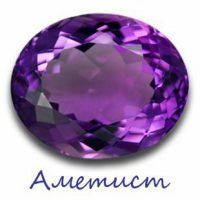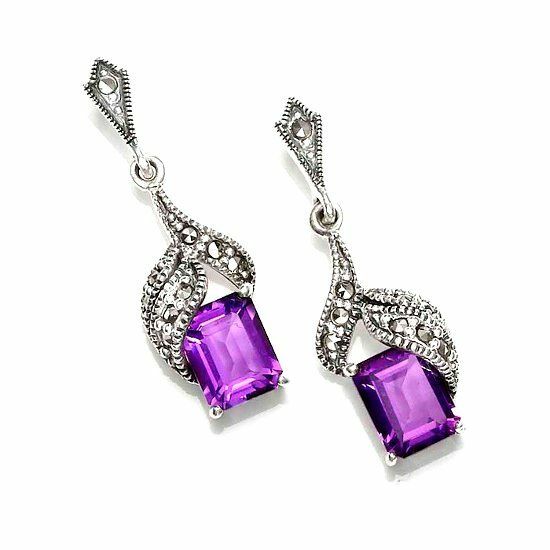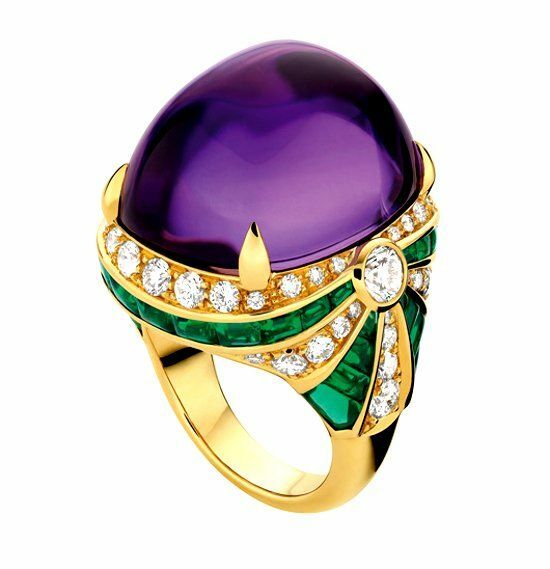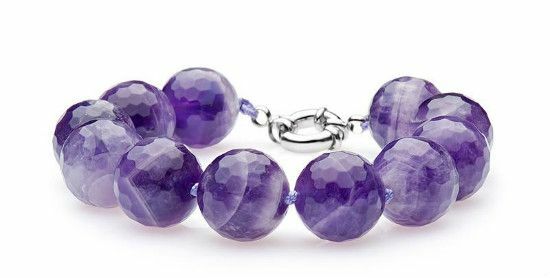
Amethyst is a beautiful popular second-order gemstone, which, due to its properties, transparency and an unusual saturated purple hue, is often valued at the level of expensive first-order gemstones.
In many peoples, amethyst is a symbol of sincerity, honesty, peace and eternity. For many years he was a stone of priests and monarchs.
History of the stone
The history of amethyst has more than one century. Research scientists confirm that this stone has long been known in Europe and the countries of the East.
- In ancient Egypt, amethyst was called a "blessed stone", and believed that it brings its owner calm and good luck. They decorated the interior and the throne of the rulers of the country.
- In ancient Rome in ancient times it was used as an ornamental stone for making small decorative items.
- In ancient Greece believed that amethyst can save you from drunkenness and prevent a person from getting drunk with wine.
- In ancient China, amethyst made vessels for aromatic oils and balsams.
- In the Middle Ages, the amethyst acquired an important religious significance. They decorated the clothes of priests and church utensils.
- In special honor, the amethyst was among the Catholics. For many years, the tradition continued, according to which the Pope himself presented a card with an amethyst during the rite of his initiation. Because of this, the stone was called episcopal or pastoral.
- Until the 17th century, amethyst was valued in Europe along with diamonds.
- Amethyst was also appreciated in Russia. Here he was also in pride of the priests and was called the episcopal stone. He was loved by both noble magnates and crowned persons. So, the luxurious crown of Queen Irina Godunova, along with sapphires, was decorated with saturated purple amethysts.
- Since the 18th century, amethysts have become the favorite jewelery stones in many countries of Europe, and they have been widely used for making various ornaments designed not only for monarchs and priests, but also for ordinary secular people.
Description of mineral
Amethyst is a valuable jeweler's transparent or translucent stone of beautiful violet shades - from pale violet to saturated dark violet. This is the most beautiful and valuable variety of quartz. The most valuable in the world market are transparent specimens of rich purple.
The name of the stone comes from the Greek word "amethystos".The ancient Greeks believed that the stone can be protected from drunkenness and given it an appropriate name - αμέθυστος μέθυστος, which literally means "not drunk".There are other names for the stone: "stone violet", Bacchus stone, "lilac stone nobility," the stone of the apostle Matthew, bishop's stone, etc.
to the table of contents ^Amethyst varieties
Amethyst with thin hematite crystal plates or inclusions of needle crystals goethite is called "hairy. "
Chemical composition and physical properties of stone
As a kind of quartz, amethyst belongs to silica in its species. Like any other silicon oxide, amethyst has such a chemical formula: SiO2.
Amethyst may contain iron, manganese and cobalt as impurities.
In nature, amethyst can be found in the form of elongated transparent or translucent prismatic individual crystals resembling scepters, as well as drums of diamond-shaped form with glass shine. Usually it grows in rocks on a gray opaque substrate.
The main feature of amethyst is its unusual purple color, the saturation of which varies from very pale to almost black. This stone looks most advantageous in natural light, which emphasizes its brilliance and beauty of color.
Different experts explain the unusual color of amethyst in different ways: some say that such a shade of the stone is given by admixtures of cobalt, manganese and iron, others argue that the reason for the purple shade of the stone is the presence of organic coloring pigments, and still others see the reason for such unusual staining of the stonein the defects of its crystal lattice and inclusions of iron ions.
It's interesting that under the influence of direct sunlight this beautiful stone loses its color and gradually burns out. It is estimated that for every 25 years of sun exposure, it loses about 20% of its intensity.
When heated to a temperature of 200 ° C to 250 ° C, the amethyst quickly loses its original color and becomes first yellow, then greenish, and eventually discoloration. Cooling down, it again becomes purple, but if it is heated above 300 ° C, it will remain colorless.
Amethyst is a pretty solid stone. Its hardness on the Mohs scale is 7.0 units, and its density is 2.6 g / cm3.
to contents ^Amethyst deposits
The largest amethyst deposits are in Brazil, Russia and Sri Lanka. Amethysts are also mined in India, USA, Canada, Uruguay, Namibia, Burma, Bolivia and Madagascar.
to contents ^The healing properties of
mineral Lithotherapists claim that amethyst is endowed with healing properties that help:
- strengthen the immune and endocrine systems;
- to cure nervous diseases;
- relieve stress;
- get rid of insomnia;
- cleanse the blood;
- get rid of a cold;
- to heal kidney and bladder diseases;
- increase brain activity;
- to heal diseases of the liver and gallbladder;
- heal skin diseases;
- strengthen the stomach;
- to improve the eyesight.
It is also believed that amethyst can protect a person from infectious diseases and nervous breakdowns, and also help to preserve youth. For medical purposes, it is recommended to use the stone itself, and to use thawed water infused on it.
to contents ^Magical properties of amethyst
Among the magical properties of amethyst is attributed the ability to bring good luck and joy, to give its owner the courage, faith in himself, the hope for the best and vigor of spirit.
It is believed that amethyst can help a person develop inner abilities and comprehend universal wisdom.
But the main magical power that the amethyst possesses, according to esotericists, is its ability to protect its owner from all kinds of temptations and temptations. It is not for nothing that he is considered an amulet of alcoholism and drug addiction.
to the table of contents ^Amethyst and zodiac signs
According to astrologers, the most stone amethyst is suitable for people born under the signs of Aries and Aquarius. So, Aries he will help to cope with excessive impulsiveness and control emotions in decisive situations, and Aquarius amethyst protects from evil people and helps restore spiritual strength.
But the Lions and Taurus wear amethyst as an amulet or amulet astrologers do not recommend.
to the table of contents ^Application of the gem
Traditionally, amethyst is used as an expensive jewelery and ornamental stone for the manufacture of various jewelry and decorative items, inlaid church attributes.
Usually for jewelery processing of amethyst, faceted wedge cut in the form of a drop( pear) or oval is used. Occasionally, for processing stones of low quality, a cabochon cut is used.
to table of contents ^Interesting facts about the stone
- According to the ancient Greek legend, the amethyst appeared thanks to the god of wine Dionysus( Bacchus) and the goddess of fertility Artemide. Allegedly insulted by inattention to his own person, Dionysus vowed to take revenge on mortals and to persecute the first encounter with brutalized tigers. The victim of the infuriated god was the beautiful Amethystos, who was heading with gifts to Artemis. Saving a beautiful young woman from the claws of animals, the goddess turned her into a quartz statue, and Dionysus, repentant in his act, shed his wine tears on a transparent female statue, painting it in an unusually beautiful violet color. Hence the second name of the stone is the Bacchus stone.
- The Romans and Greeks believed that the amethyst can help them not to get drunk during feasts and feasts and therefore put it in a glass of wine.
- In the Middle Ages, during the terrible epidemics, the amethyst was worn in the form of an amulet, believing that it can protect its owner from infection.
- The largest specimen of the stone was found in the northern part of Finland. Its weight was more than 60 kg.
How to distinguish natural amethyst from forgery
Since the first artificial amethyst was made, the probability of buying a counterfeit instead of natural stone has increased many times. Artificial amethyst is not inferior to natural stone, either in hardness or in strength, so it will not work out to distinguish it, trying to scratch it. The only way to make sure of the naturalness of the stone is to look closely at it and pay attention to the following:
- Natural amethyst contains various impregnations and specks.
- The color of natural amethyst, unlike the color of an artificial stone, is often uneven.
- When immersed in water, natural amethyst is discolored at the edges, and there is no artificial amethyst.
- Under the influence of ultraviolet natural amethyst decolorizes evenly, and synthetic only in separate areas.
Care for the stone
To preserve the beauty of amethyst and its color saturation for a long time, it must be protected from constant exposure to sunlight and overheating. And, of course, you need to protect it from blows.
To clean the amethyst and resume its beautiful shine and color, you can gently drop it into a mild soapy solution, then rinse under running water and wipe dry with a soft cloth.
to the table of contents ^Photos of the amethyst stone and its products







Thanks for what I found on your site. Thanks again.
Yours faithfully to you Victor.